
TruVision 6MP and 12MP 360° Camera Configuration Manual
37
Figure 9: Motion detection window
Defining a motion detection alarm requires the following tasks:
1.
Area settings
: Define the on-screen area that can trigger a motion detection alarm
and the detection sensitivity level (see Figure 9, item 1).
2.
Arming schedule
: Define the schedule during which the system detects motion
(see Figure 9, item 2).
3.
Recording schedule
: Define the schedule during which motion detection can be
recorded. See “Recording schedule” on page 56 for further information.
4.
Actions
: Specify the method of response to the alarm (see Figure 9, item 3).
5.
Normal and advanced configuration
: Normal configuration allows you to set the
sensitivity level of the motion detection (see Figure 9, item 4). Advanced
configuration gives you much more control over how motion is detected. It lets you
set the sensitivity level as well as define the percentage of the motion detection area
that the object must occupy, select day or night mode, and set up eight differently
configured defined areas.
To set up motion detection in normal mode:
1. From the menu toolbar, click
Configuration
>
Alarm/Event
>
Motion
Detection
.
2. Select the
Enable Motion Detection
check box. Select the
Enable Dynamic
Analysis for Motion
check box if you want to see real-time motion events.
Note:
If you do not want the detected object to be marked with the green frame,
select
Disable
from Configuration > Local Configuration > Live View Parameters >
Enable Meta Data Overlay.
3. Select
Normal
mode from the drop-down list.
















































